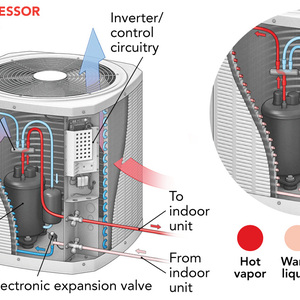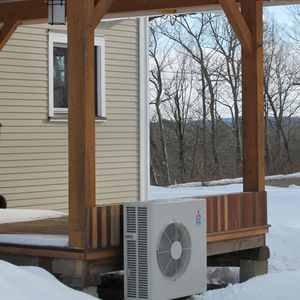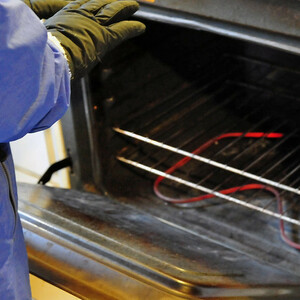
Air-source heat pumps, and particularly ductless minisplits, are becoming the go-to HVAC choice for a growing number of builders and homeowners. Tight, well-insulated houses are especially good candidates because the heating and cooling systems can be relatively simple.
But what about really old houses? Is the case for heat pump technology as compelling there?
That’s the question Curtis asks in this recent Q&A post about a 4000-sq.-ft. house dating from the 1850s in New York’s Hudson River Valley (climate zone 5b). He aims to reduce the use of fossil fuels as much as possible.
“Since the house needs a full renovation (including a new HVAC system), we were hoping to move over to a fully electric heat pump system,” Curtis writes.
The house needs a new roof, including the roof deck, so Curtis can do a substantial retrofit there, with insulation above and below the sheathing. In the basement, he plans on adding 2 in. of spray foam from the floor to the rim joist. Wall cavities, however, won’t get nearly the same attention due to historic details on both the interior and exterior of the house. Plus, on much of the first floor, there’s brick between the plaster and the exterior siding.
He’ll know more about his options once the insulation retrofits are complete and a Manual J calculation has been done. But his HVAC contractor is guessing that he’ll need to install backup propane heat, an option that Curtis would like to avoid.
“I’m curious what the thoughts are on being able to heat our house with just heat pumps,” Curtis says, “and more generally, what people’s experiences are with larger older houses and heat pumps when it comes to comparing expense to efficiency to comfort.”
That’s where…
Weekly Newsletter
Get building science and energy efficiency advice, plus special offers, in your inbox.

This article is only available to GBA Prime Members
Sign up for a free trial and get instant access to this article as well as GBA’s complete library of premium articles and construction details.
Start Free TrialAlready a member? Log in















9 Comments
With the sophisticated energy modeling programs available today, time would be well spent using one. The walls will need cellulose dense pack to have any hope of comfort. If one is to consider the green aspect, fuel choice and source of electricity should be accounted for.
Is there some acreage here that could be rewilded? As in local ecotype native vegetation. This would offset some of the carbon.
Why not use exterior insulation when the roof needs rebuilding? I see by the photo that the roof line along with corbels can all be pushed out. The window trim looks pretty standard for that time so push that out as well. That's what I do in WI for the 1800s homes. Lots of work but that's why we're here, right?
I’m an old house contractor in zone 5 coastal CT. We are on our second old house project using heat pumps. The first is from 1780 or so, the current project is 1747, but have worked on many mid 19th century homes as the one in this article.
The 1780 house is doing just fine with no backup heat whatsoever, but it is fairly well insulated and has new double pane windows.
90% of the walls of this house are insulated with Roxul from the outside. We removed the original clapboards, sheathing, made some structural repairs, put in the insulation, then plywood sheathing with joints taped, then a drainable house wrap and new Cedar shingles. We have done this on many other old homes.
Here is a link to the owners blog on the 1780’s house… https://enoskellogghouse.blogspot.com/2012/05/facelift.html
And here is some very basic Energy usage data on the house…https://rjaley.com/Norwalk_CT_RJAley_Energy_Efficient_Construction.pdf
On our current project the main house is from 1747. It will have three fully ducted heat pump/air handlers.
Because this is a whole house renovation, I hired someone to do the heat loss calcs and they recommended propane-hot water backup heat coils in each AH, but my gut experience tells me they will rarely be needed.
In both of these houses there are fully ducted heat pumps located in the well-insulated attics.
To insulate the attics of both these houses we sister’ed the existing timber frame rafters that are typically on 42” centers with 2x8 or 2x6 rafters 16” on center. Between the new rafters we install vent baffles, then fiberglass insulation and then 2” foil faced foam board over the new rafters with all seams tightly taped. You can see this system in the attached article. I see Curtis's house has sawn rafters that look like they are on 16" or 20" centers so that’s a plus.
This system avoids over the roof deck insulation yet still provides a thermal break across the rafters, plus, if your existing roof is in good shape you don’t need to destroy it to insulate, but I understand you need a new roof and roof deck, but even if you are replacing the roof and deck this system wont alter the original historic roof lines that are an important part of its history.
I try to avoid spray foam particularly on attic roofs as future roof/chimney flashing leaks are often masked by the spray foam until lots of damage is done.
After insulating the attic be sure to look at the basement bulkhead, at the bottom of that stair you should have a well-insulated, weather stripped door. Attached article also covers that.
A house from 1850’s is not a colonial, I would call this house Italianate due to the elaborate roof brackets and date of 1850’s.
The actual Colonial period ended with the end of the American revolution and the style associated with it, Salt boxes, Capes etc.. was replaced by the Federal style, roughly 1785 to 1840. After the Federal period came the Romantic styles, 1840 to 1880 such as Greek Revival and Italianate like this house.
A Covid inspired consideration inclines me to offer my a bias toward minisplits, or at least one in a separate area (not conditioned by communicating ductwork). In the event someone in your household has the flu or a cold or worse, being able to "seal-off" a separate conditioned area that does not share germs with other areas is worthy of consideration. We've personally been fortunate to have no Covid at home (other than a scare of exposure from outside our household that quarantined me for 2 weeks-in a well insulated bedroom, with masked trips to the kitchen and bathroom). This scare brought more to light the advantages of minisplits vs whole house ducted systems. For those in Texas, Feb. 2021 illuminated the limitations of back-up electric heat, you need electricity and lots of it, and they didn't have it when they needed it. Multiple minisplits can be load-shed easier (for a limited generator, be it gas, propane or PV) than a larger central heating heat pump...or 2. PV on the roof is subject to snow cover so perhaps a dual axis tracker that dumps snow, then the only limitation is cloudy days. If a permanent generator, go big like greater than 20 kW, or even water cooled. Code might require it if you want full backup of the whole home as square footage energized drives kW power requirements, too.
After watching This Old House for years, it's cool to see the Trethewey name on GBA.
Ross Trethewey said: “In the Northeast, many older buildings have an existing forced hot water baseboard or cast-iron radiator system. For homes that are not well insulated/air-sealed or for homeowners who are concerned about the effectiveness of the minisplit system, we recommend they leave their existing heating system in place.”
Can I do that with a heating oil boiler, with it (and the fuel) just sitting idle for all but a couple of days a year?
David-
I'm sure you will be fine if you do that. Your boiler its probably a warm start boiler, meaning it is set to maintain a constant temp inside of of 100 - 120 degrees year round, warm start will keep the boiler fire box and heat exchanger cleaner and will keep the chimney warm inside and thus reduce condensation which might otherwise freeze up and damage the chimney and damage the inside of the boiler. If by chance you have a cold start boiler then I would consider setting it up as a warm start as there are many benefits as I said above and the amount of oil you will use is minimal to keep it warm.
I see some homeowners turn of the red switch for the whole summer because they hear their boiler running periodically, but that is a mistake to turn it off since you will shut down the warm start aspect of the boiler and all its benefits. I have seen 60 year old warm start boilers that are well maintained running at 78-82% efficient.
Get a oil tech over to your house and find out if the boiler is set up as a warm start, if not ask them to set it to be that way.
Where do you get your hot water from?
That’s good news, thanks. The idea I had about boilers sitting idle must have been about cold-start boilers.
The hot water is from the boiler. I’m thinking of ductless mini splits for heat and the boiler for hot water but only for a while until I can put in an alternative, probably electric because most hot water use will be off peak.
But what I’d really like to do is retrofit the existing baseboard oil-boiler system with an air-to-water heat pump system. I’ve read Brian Just’s 2/26/20 “Air-to-Water Heat Pump Retrofit” article, the 5/9/22 Q&A article “Options for Replacing a Boiler.” Soon I hope to be able to articulate some specific questions about possibilities for my newly purchased 1867 two-story 70x30 foot brick building.
As long as your getting your hot water from the boiler then you wont have any concerns about the boiler sitting idle.
Log in or become a member to post a comment.
Sign up Log in